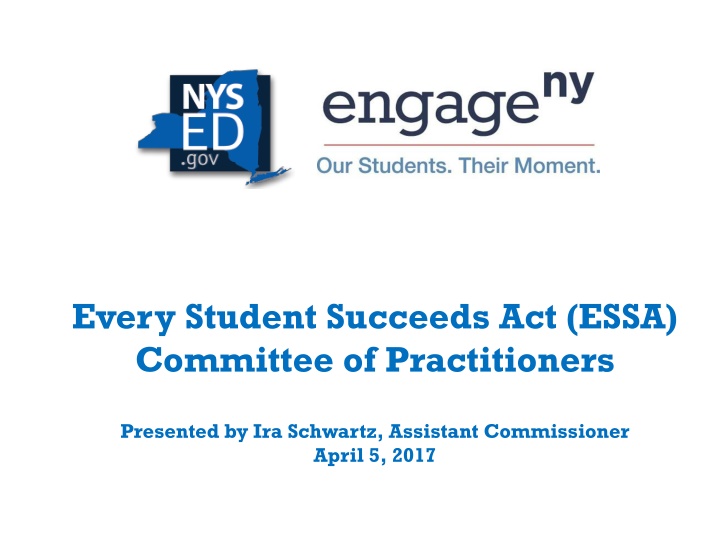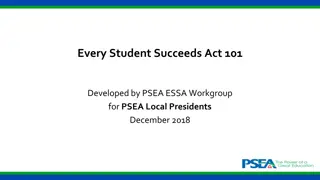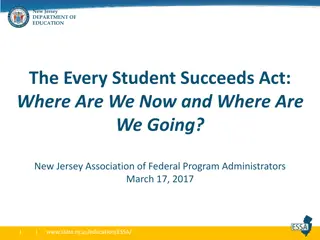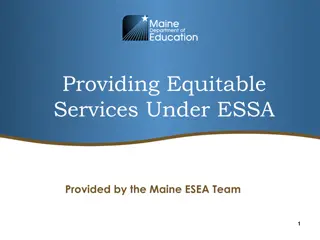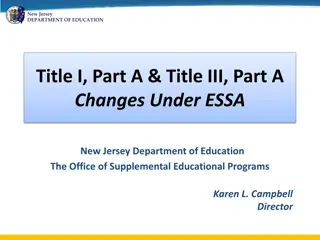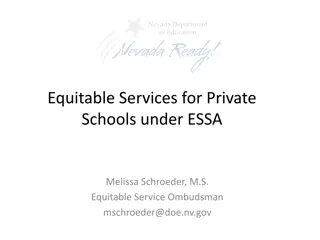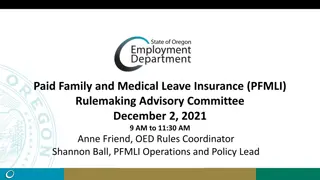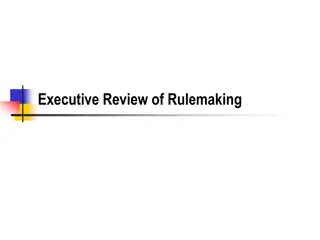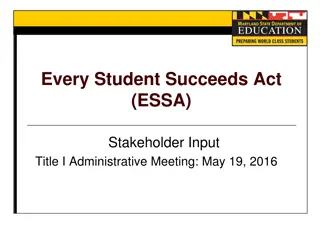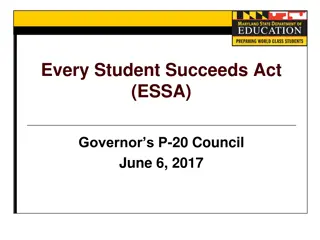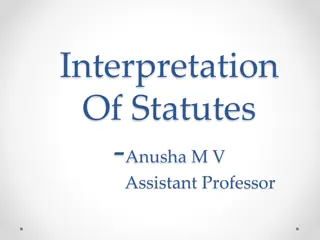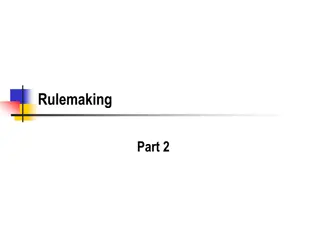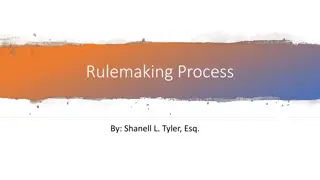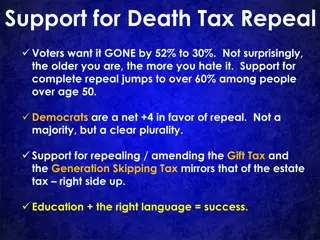Implications of Repeal of ESSA Rulemaking: Overview
The Every Student Succeeds Act (ESSA) implications of the repealed rulemaking, including assessment provisions and accountability regulations, are discussed in this overview. The impact on high school graduation rates, measuring student performance, and reporting requirements are highlighted.
Download Presentation

Please find below an Image/Link to download the presentation.
The content on the website is provided AS IS for your information and personal use only. It may not be sold, licensed, or shared on other websites without obtaining consent from the author.If you encounter any issues during the download, it is possible that the publisher has removed the file from their server.
You are allowed to download the files provided on this website for personal or commercial use, subject to the condition that they are used lawfully. All files are the property of their respective owners.
The content on the website is provided AS IS for your information and personal use only. It may not be sold, licensed, or shared on other websites without obtaining consent from the author.
E N D
Presentation Transcript
Every Student Succeeds Act (ESSA) Committee of Practitioners Presented by Ira Schwartz, Assistant Commissioner April 5, 2017
ESSA Updates The Every Student Succeeds Act (ESSA) remains in effect. Rulemaking pertaining to the assessment provisions of ESSA are now final and in effect. Draft rulemaking regarding the supplement not supplant provisions of ESSA were withdrawn in January 2017 by the Obama administration. On February 7, 2017, the House of Representatives voted to repeal the rulemaking pertaining to accountability, data reporting, and state plans. On March 9, 2017, the Senate also voted to repeal this rulemaking. Once this Joint Congressional Resolution is signed by the President The United States Department of Education is prohibited from issuing similar regulations to replace those repealed. The dates for submission of State plans remain April and September 2017. A revised state template was provided by USDE to states on March 13, 2017. 3
Implications of Repeal of Rulemaking The Law: (i) beginning with school year 2017 18, and at least once every three school years thereafter, one statewide category of schools for comprehensive support and improvement, which shall include (I) (II) all public high schools in the State failing to graduate one third or more of their students; The Rulemaking: Identify: (2) Low high school graduation rate. Any public high school in the State with a four-year adjusted cohort graduation rate, as calculated under 200.34(a), at or below 67 percent, or below a higher percentage selected by the State. 4
Implications of Repeal of Rulemaking The Law: (ii) For the purpose of measuring, calculating, and reporting include in the denominator the greater of (I) 95 percent of all such students, or 95 percent of all such students in the subgroup, as the case may be; or (II) the number of students participating in the assessments. The Rulemaking: (1) Annually calculate so that the denominator of such measure, for all students and for all students in each subgroup, includes the greater of-- (i) 95 percent of all such students in the grades assessed who are enrolled in the school; or (ii) The number of all such students enrolled in the school who participated in the assessments 5
Overview of the New Template
Background Both the House and Senate have voted to roll back ESSA Accountability and State Plan regulations (originally made final in November 2016) through the Congressional Review Act; President Trump signed the resolution into law. The initial consolidated State plan template released by USDE last year was tied to the original regulations. USDE has revised the consolidated State plan template and provided guidance on the plan submission and approval process. The new template is the current Administration s determination of what is absolutely necessary to include in a consolidated State plan. 7
Key Submission Considerations April 3, 2017 and September 18, 2017 are still the two deadlines for States to submit their state plans. Under guidance issued by USED, States have three options for submitting their plans: They may use the new template; They may use an alternative template that is developed by the State in partnership with the Council of Chief State School Officers and addresses each of the requirements in the USDE template; or, USED has affirmed that a version of the previous template could be submitted through this option They may submit plan for individual programs that address the statutory requirements. In addition to the information included in the revised template, States will need to submit a series of assurances applicable to specific programs, which USDE will make public in the near future. 8
Key Content Changes The revised template is organized by program (most of the original template was organized thematically); the template carries over certain provisions from the previous template, but also makes numerous changes, including removing, adding, and rewording requirements. 9
Included Programs Title I, Part A: Improving Basic Programs Operated by Local Educational Agencies Title I, Part C: Education of Migratory Children Title I, Part D: Prevention and Intervention Programs for Children and Youth Who Are Neglected, Delinquent, or At-Risk Title II, Part A: Supporting Effective Instruction Title III, Part A: English Language Acquisition, Language Enhancement, and Academic Achievement Title IV, Part A: Student Support and Academic Enrichment Grants Title IV, Part B: 21st Century Community Learning Centers Title V, Part B, Subpart 2: Rural and Low-Income School Program Title VII, Subpart B of the McKinney-Vento Homeless Assistance Act: Education for Homeless Children and Youth Program (McKinney-Vento) 10
Major Differences Specific requirements to describe activities related to performance management, stakeholder engagement, and educator equity provisions are largely eliminated in the new template. In areas where both the old and new template request information, the new template asks for significantly less (and less specific) information. At the same time, several requirements in the old template to provide detailed information are not included in the new template. The new template does not discuss: Numerical limits on N sizes; Options for how assessment participation should be included in statewide accountability systems; or, Evidence requirements for school interventions. States are no longer required to provide evidence regarding how the public consultation requirements of ESSA have been met. 11
Summary of March ESSA Retreat: Whole Group Discussion Chancellor Rosa began the meeting by presenting a mission for the Board of Regents: The mission of the New York State Board of Regents is to ensure that every child has equitable access to the highest quality educational opportunities, services and supports in schools that provide highly effective instruction aligned to the state s standards, as well as positive learning environments so that each child is prepared for success in college, career, and citizenship. 12
3/15/2025 Goals The Accountability and Continuous Improvement system will: 1. Articulate the state s expectations for districts & schools and its commitments for how it will support schools; 2. Foster quality and equity: Develop college, career, and civic readiness that prepares students for the new global economy Promote diversity, linguistic & cultural responsiveness Close opportunity and achievement gaps 3. Provide useful information that helps parents, districts, schools, and policymakers make important decisions; 4. Build capacity that allows educators, schools, and districts to be more effective; 5. Encourage continuous improvement focused on practices and outcomes that matter for student success; 6. Promote system-wide learning and innovation. 13
Tiers of Indicators State- required, Used for Federal Accountabilit y Measures used for differentiating among schools, and identifying schools for support and intervention as required by ESSA. Data must meet ESSA s requirements: comparable, differentiates among schools, and reportable by student subgroup Measures available in a comparable way across districts and schools to inform ongoing evaluation and continuous improvement processes. State- reported Tools and measures provided by the state that districts or schools may choose to use to measure and improve teaching and learning. Indicators schools and districts may adopt for their own purposes to guide their monitoring and improvement efforts. Source: Adapted fromPreparing all students for college, career, life, and leadership in the 21st Century: Superintendent s Advisory Task Force on Accountability and Continuous Improvement. (2016). Sacramento: California Department of Education. State- supported Locally Developed 15
Potential Tier I Indicators Used for Federal Accountability (Based on 2017-18 School Year Results) Academic Performance (Measured by Performance Index) ***Elementary/Middle and High School ELA & Math ** Elementary/Middle and High School Science (performance-based assessment) * High School Social Studies (emphasis on civics & democracy) Greater Weight ** English Language Proficiency Gains Growth and Progress ** Individual student growth (Grade 4-8 ELA and math) **School Progress: -- ELA and Math -- Science, Social Studies, Grad Rates, Absenteeism, College, Career and Civic Readiness ***Graduation Rates 4, 5, 6 year (equally weighted) **Chronic Absenteeism ***College, Career, & Civic Readiness (High School Success Index + other measures ) 16
College, Career & Civic Readiness 1. AP / IB/ Dual Credit courses; 2. Postsecondary enrollment/ persistence (once data are reliable) 3. College prep coursework completion (if data allow) 4. State Seal of Civic Engagement [via Community Service, civic engagement project, or other], if adopted by BOR Career 5. CTE Pathway completion; 6. Industry-recognized credentials 7. State Seal of Biliteracy 8. Successful Completion of Coursework for Graduation 9. High School Diploma Types Note: Indicators in Red will be used beginning with 2017-18 School Year. Indicators in Blue will be used when approved and ready.
Potential Tier II Indicators State-Reported: Used for Diagnosis and Improvement (Some could move to Tier I, when ready, if appropriate) Opportunity to Learn Indicators: ***Curriculum access (STEM, arts, music, PE, social studies, early learning) **Resource access ($, qualified & experienced teachers, staffing ratios, etc.) **Teacher turnover / attendance *Safe, adequate, clean facilities ***School safety (Incidence rates; also sense of safety if survey data become available) *Teacher Learning Opportunities (e.g. access to professional development) **High school readiness indicator / Secondary school on-track indicator **Suspension rates (out of school) ***Student Attendance
Potential Tier III Indicators (State-Supported Measures/Tools that LEAs Can Use) School Climate Surveys (student, teacher, parent) pilots currently underway Performance Assessment Tools (tasks, rubrics, scoring protocols) Meaures of Student Integration - The extent to which students of different groups (by race/ethnicity, SES, EL status, and students with disabilities) are in schools and classrooms together relative to their presence in the district as a whole. Measures of teaching and learning conditions (e.g. TELL survey) Measures of professional development quality Measures of parent / community involvement & engagement 19
21 What does the law say? (C) ANNUAL MEANINGFUL DIFFERENTIATION. Establish a system of meaningfully differentiating, on an annual basis, all public schools in the State, which shall (i) be based on all indicators in the State s accountability system under subparagraph (B), for all students and for each of subgroup of students, consistent with the requirements of such subparagraph; (ii) with respect to the indicators described in clauses (i) through (iv) of subparagraph (B) afford (I) substantial weight to each such indicator; and (II) in the aggregate, much greater weight than is afforded to the indicator or indicators utilized by the State and described in subparagraph (B)(v), in the aggregate; and (iii) include differentiation of any such school in which any subgroup of students is consistently underperforming, as determined by the State, based on all indicators under subparagraph (B) and the system established under this subparagraph.
22 What does the system look like? We really have two related, but separate systems: High schools Elementary and middle schools In fact, depending on the School Quality and Student Success indicator(s) selected for middle schools, we might have three systems
23 A Schematic of the High School System This is the 20,000 foot view. We will zoom in on the various components on the following slides. Overall Determination School Academic Progress English language proficiency Achievement Index Graduation Rate Postsecondary Readiness Student progress on NYSESLAT
24 Zooming into the HS system-Academic indicators School Academic Progress Achievement Index Social Studies Science ELA Mathematics
25 Zooming into the HS system- Graduation Rate Graduation Rate 4 year adjusted cohort rate 5year adjusted cohort rate 6 year adjusted cohort rate
26 Zooming into the HS system- Readiness Postsecondary Readiness Civic Engagement & Literacy* College Readiness Career Readiness CTE Pathway Completion/ Industry Certification/ Seal of Biliteracy AP, IB, Dual Enrollment & Success Regents Diploma with Advanced Designation Service learning, civic engagement, other*
27 The Elementary/Middle School System Overall Determination English language proficiency Chronic Achievement Index School Academic Progress Student Growth Absenteeism/Attendance Student progress on NYSESLAT %students absent 10+ days
28 Zooming into the 3-8 system- Achievement/Progress School Academic Progress Achievement Index Science ELA Mathematics
29 Zooming into the 3-8 system-Student Growth Student Growth ELA Math grades 4-8 grades 4-8
30 Weighted composite elementary example School Achieve x 0.25 Progress x 0.25 Growth x 0.25 ELP x 0.15 Chronic Absence x .1 2 3 3 2 Total Score 1.85 3.00 2.75 1.90 PS 1 PS 2 PS 3 PS 4 3 4 2 1 2 2 2 2 1 3 4 2 1 3 3 3 In this example of a weighted composite model, four fictional schools are used with the weights indicated in the header. All the indicators were first converted to a common scale (1-4 in this case) before creating the total composite. This is not a requirement but used here for simplicity.
31 Profile/Decision Rules Example--Elementary School Achieve Progress Growth PS 1 4 4 PS 2 3 3 PS 3 2 2 PS 4 1 1 PS 5 1 2 Absent 4 3 2 1 2 ELP 4 3 2 1 3 Overall Level 4 4 3 2 1 4 Level 3 Level 2 Level 1 Level 1/2? Level 2/3? Level 2/3? 3 1 2 2 3 PS 6 2 4 3 2 4 PS 7 As you can see, the homogeneous profiles are easy to evaluate. The heterogeneous profiles require decision rules to make determinations. For example, for E, F, G, decision rules could result in all of these schools be same level (2) or each being a different level (1, 2, 3).
32 Identification for Comprehensive Support We have been discussing two potential options, both of which are based on the notion that low achievement, combined with other factors, puts the children most at risk For high schools, keep in mind that all high schools with graduation rates (can use 6 year rate) less than 67% must be identified for Comprehensive Support and Improvement
33 Center for Assessment/LPI. NY Regents Retreat. March 27, 2017 Potential CSI-ID Approach #1 (Elementary) School Achieve Growth Progress Chronic Absence ELP Decision Low Low Low Low Low Low Low PS 11 PS 12 PS 13 PS 14 PS 15 PS 16 PS 17 First, we identify Title I schools with very low achievement, likely in the lowest 10% or so of the state distribution.
34 Center for Assessment/LPI. NY Regents Retreat. March 27, 2017 Potential CSI-ID Approach #1 (Elementary) School Achieve Growth Progress Chronic Absence ELP Decision Low Low Low Low Low Low Low Low PS 11 PS 12 PS 13 PS 14 PS 15 PS 16 PS 17 Average Average Low Average High High Watch? Watch? We then look at the growth indicator and we see evidence of high growth for schools 16 & 17 which might allow the school to be placed on a watch list or to avoid identification altogether.
35 Center for Assessment/LPI. NY Regents Retreat. March 27, 2017 Potential CSI-ID Approach #1 (Elementary) School Achieve Growth Progress Chronic Absence Low Aver. Aver. Aver. High Aver Low ELP Decision CSI Low Low Low Low Low Low Low Low Low Aver. Low Low Low Aver Aver Low Aver. Low Aver. High Aver Low PS 11 PS 12 PS 13 PS 14 PS 15 PS 16 PS 17 CSI Average Average Low Average High High Watch? CSI Watch OK? Watch? We then follow this procedure by examining school performance on the rest of the indicators to evaluate whether the schools should be placed on a watch list or to avoid identification altogether.
36 Center for Assessment/LPI. NY Regents Retreat. March 27, 2017 Potential CSI ID approach #2 (growth & achievement) Accountability Status of Elementary and Middle Schools Based on 2014-15 ELA and Math Achievement and Growth Results Accountability Status 200 Good Standing Local Assistance Plan Focus Schools 150 2014-15 Average Combined 3-8 ELA and Math Priority Schools What do we value: achievement or growth? We can adjust axis until we ID 5% of Title I schools. We can rely on signal-detection theory to help fine-tune our selection. Performance Index 100 50 0 20 30 40 50 60 70 80 2014-15 Average MGP
Group Discussion: Supporting Excellent Educators As required under Title I, Part A of ESSA, NYSED must identify whether minority and low-income students in Title I schools are assigned to ineffective, out-of-field, or inexperienced teachers at disproportionate rates. Board members agreed that: We should continue to use the definitions for minority and low-income students and out-of-field teachers, as found in NYSED s 2015 Plan to Ensure Equitable Access to the Most Effective Educators. The Department should explore changing the definition of inexperienced teachers from first year teachers to teachers with three or fewer years of experience. The Department should produce district-level equity profiles and provide technical assistance to districts where there are significant gaps in equitable access to effective, qualified, and experienced teachers to help identify strategies to close those gaps. Board members expressed concern with using the overall composite Annual Professional Performance Review (APPR) ratings or any student learning measures associated with APPR for purposes of defining ineffective teachers. 38
Group Discussion: Supports and Improvements for Schools Discussion Summary: Low-performing schools should have input into the interventions they choose, but there needs to be recognition that lack of capacity to correctly choose the most appropriate interventions and to successfully implement them is frequently a major impediment to improvement of results in low-performing schools. Interventions should be based on the degree to which the school lacks the foundational structures for success, the specific needs of the school, and the school s capacity to address these needs. NYSED needs to ensure that when vacancies in leadership occur, these vacancies are filled by school leaders with specialized preparation in school turnaround. There were four initial areas that were identified as fundamental for building a platform for success in these schools. Consequently, these areas should be closely examined in the needs assessment conducted: How schools organize the instructional day and use instructional time; The coherence of the curriculum being used; The effectiveness and cohesiveness of professional development; and, The capacity of school leadership to change school culture. 39
Group Discussion: Innovative Assessment Demonstration Authority (IADA) Discussion Summary: The main benefit of IADA is that it will provide flexibility to address specific issues in our education and assessment systems. The New Innovative Assessment will start as a pilot and must be scaled statewide to replace current state assessment by the end of a 5-7 year demonstration period. No additional funding is provided for IADA states. Planning with potential partners should begin as soon as possible. 40
ESSA Public Hearings The Department plans to ask the Board of Regents at its May meeting for approval to post a draft application for public comment. During the public comment period, the Department will host 13 Regional ESSA Public Hearings during May and June, five in New York City and eight in Rest of State. Hearings will be open to the public; persons may sign-in at meeting site for speaking slots. Persons may also submit comments via e-mail and/or snail mail. Dates and general locations have been released. More details on specific locations and times will be released shortly. 42
ESSA State Plan Timeline Activity Date May 2017 Board of Regents Meeting Staff will present draft plan and seek permission to release for public comment. May 8 - 9, 2017 The Department, with Board approval, will release the draft plan for public comment. May 10 June 15, 2017 Public Hearings on Draft Plan. May 11 June 15, 2017 July 2017 Board of Regents Meeting Staff will present any changes to the draft plan based on public comment, and request permission to send revised draft state plan to Governor. July 17 - 18, 2017 Application with Governor for 30 days. July 19 August 18, 2017 September 2017 Board of Regents Meeting Staff will seek approval to submit final state plan to USDE. September 11- 12, 2017 Deadline to submit ESSA State Plan to USDE. September 18, 2017 43
